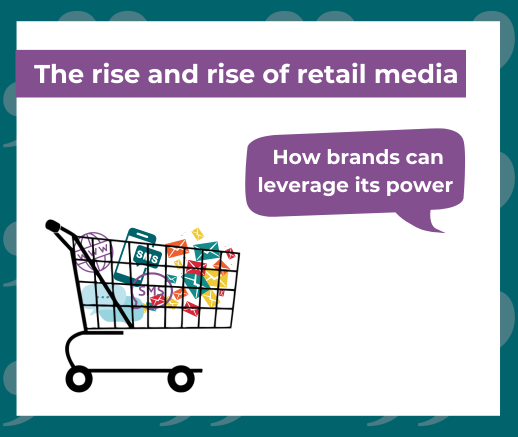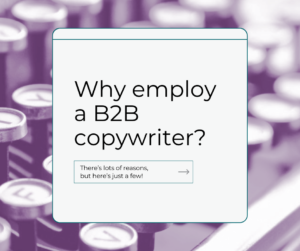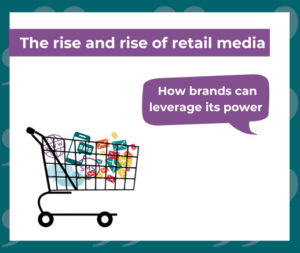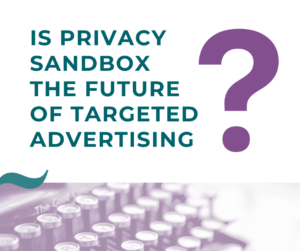Retail media first started to see signs of significant growth in 2016, and it only took five years to 2021 for the market to grow from $1bn to $30bn – less than half the time of social media and a third of the time of search to reach the same figures.
What drove this meteoric growth? There are four key factors that Econsultancy suggests created this opportunity for retail media:
- Retailers facing mounting pressure to unearth new income streams and boost profit margins.
- Brand leaders struggling to drive growth in fiercely competitive markets.
- Brands needing to pivot their targeting approach with the crumbling of third-party cookies.
- The evolution of online consumer behaviour impacting customer journeys and purchasing decisions.
Of course, retail media providers have benefited hugely from this revenue stream. However, it also provides opportunities for brands and agencies to effectively reach new and existing customers.
In this quick guide, we’ll cover what retail media is, its unique value proposition, best practices that brands and agencies can use to take advantage of this massive advertising channel, and examples of brands succeeding with retail media.
What is retail media?
Retail media is the ad space ecommerce retailers sell on their websites or apps to brands who want to influence buying decisions at the point of purchase. However, this can also apply to advertisements retailers place inside their physical stores.
According to Criteo, retail media “enables brands to boost their visibility on the digital shelf”, similar to an endcap or special in-aisle feature in a physical store.”
To manage this channel, retailers have created Retail Media Networks (RMNs), where they can manage their owned media promotional placements and third-party brand advertisements.
Although similar to PPC and Paid Search, the main difference with RMNs is where the ads appear (i.e. on a retailer’s site/app versus Google search results).
A unique value proposition for brands
According to the Skai State of Retail Media 2023, “96% of surveyed individuals confirmed that their retail media programs achieved desired brand impact.”
The primary benefit RMNs provide is access to the retailer’s first-party data for relevant and accurate targeting capabilities, which has gained significant importance with the coming demise of third-party cookies.
Another benefit is providing a brand-safe environment, giving brands the confidence that their ads won’t appear alongside misinformation, hate speech or other types of content they don’t want to associate with (a common downside of advertising in social walled gardens).
For agencies, retail media platforms create a streamlined media buying process to help track and manage campaigns across multiple retailers.
Key players in retail media
It’s no surprise that Amazon is currently dominating the market share of retail media globally, and in Europe specifically, it’s almost 640% ahead of its closest competitor, eBay.
In the US, Amazon is still at the top of the leader board as the most important RMN to marketers, but Walmart and Target are in close pursuit, with others such as Instacart, Kroger, Meijer, and Best Buy trailing behind.
In the UK, dominant RMNs include Tesco, which launched its RMN towards the end of 2021 and continually evolves its offering thanks to 21m Clubcard holders; and Sainsbury’s (powered by Nectar360), which boasts the UK’s largest coalition loyalty programme with over 20m members.
Retail media best practices for brands and agencies
While the benefits of including retail media in the marketing mix are clear, how can brands leverage its power?
Foster collaboration, not silos: Investing in retail media isn’t a one-department decision. It affects marketing, ecommerce, trade marketing, finance, and multiple key decision-makers within the business, particularly those developing brand strategies. To avoid missing critical information and conflicting interests, it’s best to create internal collaboration opportunities and data-sharing rather than operating in silos.
Invest in building expertise: Even if outsourcing advertising to agencies, it’s still best practice to develop internal expertise on retail media to provide overall strategy and better understand the impact of campaigns. Having internal data analysts and experience in performance marketing are great foundations for transitioning into a retail media strategy.
Be selective with RMN partners: Rather than relying on ‘spray and pray’, a better approach is to evaluate potential partners according to your most important criteria using a joint business planning strategy:
- Does the retailer’s positioning and objectives align with the brand?
- What are their strengths and weaknesses, and their short vs long-term goals?
Answering these questions can help narrow down potential RMN partners that would provide the best collaboration opportunities for the brand.
Identify the right metrics: Finally, when building a retail media strategy, it’s crucial to consider which KPIs should be tracked according to the brand’s goals. For example, if the goal of the campaign is to increase customer acquisition, brands can use the RMN to track product sales, sometimes even at the SKU level. However, if the goal is to increase brand awareness, the RMN should be able to report on the number of impressions the ads achieve.
If partnering with multiple RMNs, it’s important to understand there is no industry standard – each network will be working to its own methodology in terms of campaign execution and reporting.
Brands doing it right: examples of retail media campaigns
There are a number of brands seeing overwhelming success with retail media. Here are just a few we’ve handpicked from Amazon case studies:
Solo Fresh Coffee
The Japanese coffee brand Solo Fresh Coffee saw a noticeable decline in product page visits, and their sales had seemingly peaked, so they reevaluated their strategy to focus on brand awareness. They hired Barriz, an Amazon Ads advanced partner, and using Amazon’s media planning suite and Amazon’s DSP, achieved their goals:
- They increased the volume of the audience browsing Solo Fresh Coffee’s product detail pages by 209% YoY in January to March 2023.
- Compared with sales goals, actual sales increased by 14.4%, while YoY sales went up 35%.
Jameson
The best-selling Irish whiskey in the world, Jameson wanted to drive awareness of its Black Barrel product and credentials during a key, yet fiercely competitive selling period in the alcoholic beverage industry: Christmas.
Jameson developed full-funnel activation with Amazon Ads with an omnichannel measurement strategy (which included an offline sales study with Circana Lift). The results of their campaign were impressive:
- Streaming TV ads delivered a 98% completion rate, exceeding the Amazon Ads internal benchmark.
- The campaign also drove a strong ROI across offline and online sales, with a 31% uplift vs Circana benchmarks, while offline sales specifically saw an 81% uplift vs Circana benchmarks.
Milk-Bone
For dog lovers worldwide, Milk-Bone is a household brand of dog treats that cater to every dog’s age, dietary needs, and palate. What’s particularly interesting about this case study was the use of Alexa interactive audio ads to create a branded audio experience.
The success Milk-Bone found in this case study shows great promise for voice-activated devices and advertisements:
- Amazon’s first-party insights showed a new-to-brand rate of 31% among customers who asked Alexa to add Milk-Bone products to their basket, outperforming the category benchmark rate by 1.4X.
- The results from a campaign-specific brand lift from a third-party measurement vendor, Kantar, showed a 1.7X consideration lift due to the exposure from branded experiences with Alexa.
- Over 11K users engaged with the More Dog branded experience, with almost 86% of sessions lasting more than 30 seconds.
Now is the time to diversify with retail media
Data shows the growth of retail media will not slow down anytime soon, especially in a world where brands must reevaluate their approach to reaching their target audience without third-party cookies. Adding a retail media strategy to the marketing mix can help this obstacle into an opportunity while reaching brand new audiences.
If you need help articulating your thoughts on retail media or digital marketing, we can help. Chat with us todayto learn more.








